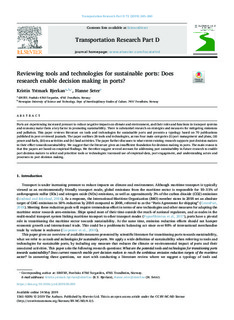| dc.contributor.author | Bjerkan, Kristin Ystmark | |
| dc.contributor.author | Seter, Hanne | |
| dc.date.accessioned | 2019-10-03T11:42:39Z | |
| dc.date.available | 2019-10-03T11:42:39Z | |
| dc.date.created | 2019-05-14T09:09:03Z | |
| dc.date.issued | 2019 | |
| dc.identifier.citation | Transportation Research Part D: Transport and Environment. 2019, 72 243-260. | nb_NO |
| dc.identifier.issn | 1361-9209 | |
| dc.identifier.uri | http://hdl.handle.net/11250/2620072 | |
| dc.description.abstract | Ports are experiencing increased pressure to reduce negative impacts on climate and environment, and their roles and functions in transport systems and economy make them a key factor in promoting sustainability. There is substantial research on strategies and measures for mitigating emissions and pollution. This paper reviews literature on tools and technologies for sustainable ports and presents a typology based on 70 publications published in peer-reviewed journals. The paper outlines 26 tools and technologies, across four main categories (i) port management and plans, (ii) power and fuels, (iii) sea activities and (iv) land activities. The paper further discusses to what extent existing research supports port decision makers in their effort towards sustainability. We suggest that the literature gives an insufficient foundation for decision making in ports. The main reason is that few papers are based on empirical findings. We therefore suggest several avenues for addressing port sustainability in future research to enable port decision makers to select and prioritize tools or technologies: increased use of empirical data, port engagement, and understanding actors and processes in port decision making. | nb_NO |
| dc.language.iso | eng | nb_NO |
| dc.publisher | Elsevier | nb_NO |
| dc.rights | Attribution-NonCommercial-NoDerivatives 4.0 Internasjonal | * |
| dc.rights.uri | http://creativecommons.org/licenses/by-nc-nd/4.0/deed.no | * |
| dc.title | Reviewing tools and technologies for sustainable ports: Does research enable decision making in ports? | nb_NO |
| dc.type | Journal article | nb_NO |
| dc.type | Peer reviewed | nb_NO |
| dc.description.version | publishedVersion | nb_NO |
| dc.source.pagenumber | 243-260 | nb_NO |
| dc.source.volume | 72 | nb_NO |
| dc.source.journal | Transportation Research Part D: Transport and Environment | nb_NO |
| dc.identifier.doi | 10.1016/j.trd.2019.05.003 | |
| dc.identifier.cristin | 1697650 | |
| dc.relation.project | Norges forskningsråd: 281002 | nb_NO |
| dc.description.localcode | © 2019 The Authors. Published by Elsevier Ltd. This is an open access article under the CC BY-NC-ND license. | nb_NO |
| cristin.unitcode | 194,62,40,0 | |
| cristin.unitname | Institutt for tverrfaglige kulturstudier | |
| cristin.ispublished | true | |
| cristin.fulltext | original | |
| cristin.qualitycode | 2 | |

